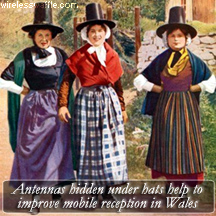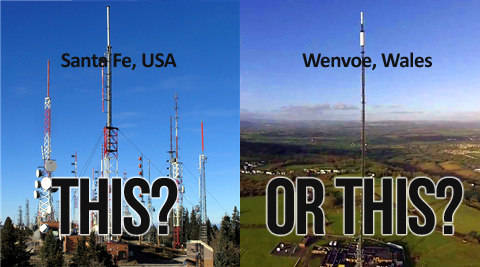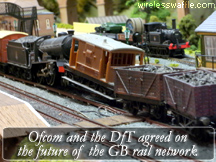Thursday 21 February, 2019, 08:53 - 5G, Spectrum Management, Much Ado About Nothing
Posted by Administrator
Back in December of 2016, the UK Government's National Infrastructure Commission published its 'Connected Future' report. It recognised that:Posted by Administrator
government must take responsibility to secure our digital future ... Government must ensure we have the infrastructure in place to deliver 5G
Amongst the various proposals in the report, many are based on the recognition that 5G will require access to orders of magnitudes more base station sites than are currently deployed for 4G.
This makes a lot of sense. Local planning restrictions already hamper the roll-out of mobile services, not just because local councils think that cell sites are ugly, or even that they damage the environment or health, but the application procedure to get permission to install a site varies wildly from one council to another. Simplifying, harmonising and streamlining the process is essential if the UK, or indeed any country, is going to benefit from whatever it is that 5G is going to offer.
 It seems rather short-sighted then, that the Welsh Government is still pondering a change to what are know as Permitted Development Rights (PDR) to allow mobile operators to build masts with a height of 25 metres (82 feet) with reduced planning requirements. At present, in Wales, operators are only allowed to extend the height of their masts to 15 metres (50 feet), whereas in the rest of the UK, the limit is 25 metres.
It seems rather short-sighted then, that the Welsh Government is still pondering a change to what are know as Permitted Development Rights (PDR) to allow mobile operators to build masts with a height of 25 metres (82 feet) with reduced planning requirements. At present, in Wales, operators are only allowed to extend the height of their masts to 15 metres (50 feet), whereas in the rest of the UK, the limit is 25 metres. Wireless Waffle has previously discussed the relative merits of increasing transmitter power compared to increasing antenna height and demonstrated the importance of antenna height. In an area such as Wales where the difficulty in providing coverage is exacerbated by the hilly terrain, and where a large number of mobile 'not-spots' exist, antenna height is of even greater importance. The reluctance to increase the permitted tower height comes in stark contrast to a previous move by the Welsh Government to invest £150 million in trying to provide coverage in these not-spots.

There is no doubt a fear that higher masts will make the countryside look ugly or cluttered, but the counter-balancing effect is that taller masts, means fewer masts. Imagine how many TV transmitter towers there would need to be if their height was limited to 15 metres. If Wales is to rise out of the valleys in terms of mobile coverage, the Welsh Government needs to act quickly, i.e. before 5G comes along, to ensure that the existing not-spot problems are not further heightened (see what we did there?)
As they say in Wales: "Nid yw tegell llawn caws yn cael ei ddefnyddio i ffôn symudol gyda chalon wedi'i dorri."
add comment
( 130 views )
| permalink
| 



 ( 3.3 / 98 )
( 3.3 / 98 )




 ( 3.3 / 98 )
( 3.3 / 98 )
Sunday 28 October, 2018, 09:38 - Much Ado About Nothing
Posted by Administrator
Posted by Administrator
 As it's that time of year again (which is to say late October), the time has come to give a plug to our ever growing list of One Hundred Halloween Hits. Whilst the list started out as just a hundred, it's now reached 130, so you are getting a bonus 30% free and for nothing. How good is that?
As it's that time of year again (which is to say late October), the time has come to give a plug to our ever growing list of One Hundred Halloween Hits. Whilst the list started out as just a hundred, it's now reached 130, so you are getting a bonus 30% free and for nothing. How good is that?Including such classic tracks as Thriller, Werewolves of London and Ghostbusters, if you are looking for the perfect playlist for your Halloween party this year, look, no further.
No, it's got nothing particularly to do with radio spectrum, or telecommunications but everyone needs a break, to let down their hair, put on a black cape, paint their face green and go from house to house demanding sweets (candy) from their neighbours occasionally don't they?
Thursday 30 August, 2018, 14:45 - Spectrum Management, Much Ado About Nothing
Posted by Administrator
Posted by Administrator
 Ofcom has published a report called "Advice to Government on improving rail passenger access to data services, Spectrum for trackside connectivity solutions and rail passenger data demand". In it, they examine the amount of data needed to supply connectivity to passengers and then which spectrum band is best suited to supply these needs.
Ofcom has published a report called "Advice to Government on improving rail passenger access to data services, Spectrum for trackside connectivity solutions and rail passenger data demand". In it, they examine the amount of data needed to supply connectivity to passengers and then which spectrum band is best suited to supply these needs.The amount of data that each passenger will be consuming each month is taken directly from Ofcom's "Mobile Data Strategy" which was published in 2016. These range from 50 to 200 Gbytes per month in 2025 depending on the scenario. The report assumes that 80% of this data is offloaded onto WiFi and that it will be a WiFi service that is provided on the train.
 If this is the case, the average user will consume between 40 and 160 Gbytes of WiFi data per month, which is 1.3 to 5.3 Gbytes per day. If we take Ofcom's figures that there will be between 600 and 1440 passengers on busy commuter trains, and that a typical commute on a train lasts 1 hour, then the total amount of data per hour consumed by all the passengers between 33 and 315 Gbytes. This, in turn, equates to a connectivity requirement of between 73 and 700 Mbps. Of course, this assumes that every passenger on the train uses the WiFi service that is provided, which is unlikely to be the case, especially (as Ofcom also notes) if the service requires a payment to connect to.
If this is the case, the average user will consume between 40 and 160 Gbytes of WiFi data per month, which is 1.3 to 5.3 Gbytes per day. If we take Ofcom's figures that there will be between 600 and 1440 passengers on busy commuter trains, and that a typical commute on a train lasts 1 hour, then the total amount of data per hour consumed by all the passengers between 33 and 315 Gbytes. This, in turn, equates to a connectivity requirement of between 73 and 700 Mbps. Of course, this assumes that every passenger on the train uses the WiFi service that is provided, which is unlikely to be the case, especially (as Ofcom also notes) if the service requires a payment to connect to.Having presumably done the same calculations, Ofcom has arrived at a requirement of between 400 Mbps and 3.6 Gbps, or roughly 5 times more. So either train journey in Ofcom's world are 5 times longer, or people on trains are 5 times more hungry for data than normal individuals.
 Based on these figures, Ofcom have assumed that a benchmark connectivity speed should be around 1 Gbps for trains. It has then gone on to analyse the various spectrum options, and decided that the only band that can deliver the necessary connectivity is the 26 GHz band, which is one of the bands being touted for future 5G services. It completely excludes, for example, the use of the 2.7 - 2.9 GHz band as it claims that this could only deliver 100 Mbps of connectivity (assuming that 40 MHz of it could be made available). It also discounts the 5.4 GHz band as this could only deliver 'a few hundred Mbps'.
Based on these figures, Ofcom have assumed that a benchmark connectivity speed should be around 1 Gbps for trains. It has then gone on to analyse the various spectrum options, and decided that the only band that can deliver the necessary connectivity is the 26 GHz band, which is one of the bands being touted for future 5G services. It completely excludes, for example, the use of the 2.7 - 2.9 GHz band as it claims that this could only deliver 100 Mbps of connectivity (assuming that 40 MHz of it could be made available). It also discounts the 5.4 GHz band as this could only deliver 'a few hundred Mbps'. There are, though, significant issues with the 26 GHz band:
- Coverage of a 26 GHz 'cell' is expected to be a few 100 metres only, which would mean tens of thousands of cells would be needed to cover the UK rail network.
- Trains run at up to 200 km/h, this places extreme demands on handovers if cells are close together, let alone dealing with Doppler shift and Rayleigh fading.
- The 26 GHz band has been identified as a 'pioneer' band for 5G services in Europe and is likely to be in high demand from mobile operators for their future mobile services.
 There is, however, a very simple solution to the whole problem. If we shrink the size of the rail network to be only a few hundred metres long, then the 26 GHz solution will work perfectly. This, perversely, seems to be the plan of the Department for Transport who allow companies such as Southern, Thameslink, Hull Trains and Northern Trains to implement new timetables that effectively reduce the rail network to set of toys, that can't convey passengers anyway. Bravo, Ofcom, for realising that the rail industry will be reduced to OO-gauge before long anyway.
There is, however, a very simple solution to the whole problem. If we shrink the size of the rail network to be only a few hundred metres long, then the 26 GHz solution will work perfectly. This, perversely, seems to be the plan of the Department for Transport who allow companies such as Southern, Thameslink, Hull Trains and Northern Trains to implement new timetables that effectively reduce the rail network to set of toys, that can't convey passengers anyway. Bravo, Ofcom, for realising that the rail industry will be reduced to OO-gauge before long anyway.Saturday 27 January, 2018, 09:04 - Spectrum Management, Much Ado About Nothing
Posted by Administrator
It seems that we, here at Wireless Waffle are having a bit of a spate of 'told you so' type events at the moment. Last month we spotted that Vodafone had been rapped over the knuckles for their crafty roaming fee shenanigans. Now we have spotted that Ofcom have been called out to assist drivers who couldn't lock or unlock their cars due to radio interference.Posted by Administrator
 On various occasions we have discussed how straightforward and relatively widespread the jamming of the frequencies used for your car keyfob is. Last time we discussed this it was because some miscreants had latched onto the idea and were stopping people locking their cars so that they could easily break in (more like stroll in) and take whatever they found in the glove compartments, foot wells and boots of the rich and not-so-rich.
On various occasions we have discussed how straightforward and relatively widespread the jamming of the frequencies used for your car keyfob is. Last time we discussed this it was because some miscreants had latched onto the idea and were stopping people locking their cars so that they could easily break in (more like stroll in) and take whatever they found in the glove compartments, foot wells and boots of the rich and not-so-rich. The Ofcom story is even more worrying as it suggests that jamming these devices is far easier than even we though possible. In addition to the car keyfobs we are so keen on discussing, the same frequency range (433 MHz) is also used for a wide variety of other wireless devices including wireless doorbells. These devices are relatively low power (10 milliWatts) and the idea is that they shouldn't interfere with each other as the range of transmission is very small. It seems, however, that a button on one such doorbell got stuck in the 'on' position, meaning it was constantly transmitting. This was enough to stop people in the vacinity locking and unlocking their cars. Thankfully, the brave Ofcom engineers were able to track down the problem and sanity was restored. Hurrah for Ofcom!
The Ofcom story is even more worrying as it suggests that jamming these devices is far easier than even we though possible. In addition to the car keyfobs we are so keen on discussing, the same frequency range (433 MHz) is also used for a wide variety of other wireless devices including wireless doorbells. These devices are relatively low power (10 milliWatts) and the idea is that they shouldn't interfere with each other as the range of transmission is very small. It seems, however, that a button on one such doorbell got stuck in the 'on' position, meaning it was constantly transmitting. This was enough to stop people in the vacinity locking and unlocking their cars. Thankfully, the brave Ofcom engineers were able to track down the problem and sanity was restored. Hurrah for Ofcom!Far be it for us to opine on the implications of this, but taking the earlier example from the BBC in which miscreants were jamming car locks but haven't Ofcom just provided these folk (and others with a similar inclination) with a simple, cheap and undetectable means of achieving the same outcome?
Just get hold of the push-button part of a wireless doorbell, put this in your pocket, and wander around a car park where posh cars park (maybe even buy a hi-viz jacket so it looks as if you are meant to be there). If it's a supermarket car park, collect a few trollies whilst you're waiting. When a particularly rich looking owner appears, go and stand close to their car and as they get out and get ready to press the button on their key to lock it, activate the wireless doorbell button. 'Hey presto', the car won't lock and you will be able to help yourself to their Gucci loafers and other luxury goodies.
From a radio spectrum management and perhaps more specifically a Wireless Telegraphy Act perspective, no law has been broken. From a Theft Act perspective, however, you still stand to be charged (or sit, depending on the layout of the court room).
Thanks Ofcom!

Posted using my gold-plated iPhone X, whilst wearing Gucci loafers and sipping Bollinger RD '85 on my luxury yacht moored in Saint Tropez with my 3 Aston Martins parked alongside.


